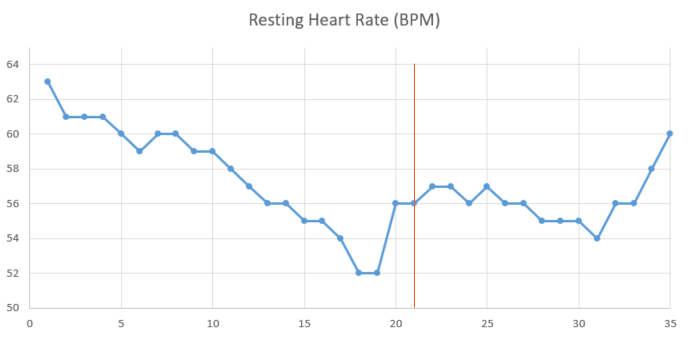21 Days Without Food: Two Weeks Later

I have changed.
It is no exaggeration to say that going 21 days without food changed my life. If you’ve ever had a “mountaintop experience” (or in this case, a Death Valley experience), you know that one of the most difficult things is integrating that experience back into your everyday life — taking the “high” of your new perspective, and weaving it into your day-in, day-out routine.
So far, though, so good. In fact, so very, very good, especially when slathered in peanut butter.
Here’s what it was like to eat again, as well as integrating all the “mind hacks,” or mental techniques, that I learned, while going 21 days drinking only water. If you haven’t already read them, you should first read my updates on:
- Why I Am Going 21 Days Without Food
- 21 Days Without Food: Week 1 Update (with photos)
- 21 Days Without Food: Week 2 Update (with photos)
- 21 Days Without Food: Week 3 Update (with photos)
- How I Made it 21 Days Without Food
The Refeeding Process
Ironically, the part of the experiment I was dreading most was starting to eat again. This was the most dangerous part of the experiment, because your body can go into something called refeeding syndrome, which can result in excruciating pain, hospitalization, and even (in extreme cases) death.
On the first day, after slowly sipping a glass of orange juice, I had 2 ounces of watermelon every two hours. Two ounces is “about the size of a woman’s fist,” said one of my doctors, and I thought, Well, that’s an oddly sexist unit of measurement. I wondered if this doctor had unresolved marital issues, so I started calling this quantity of food “the hubby hitter.”

I was not looking forward to such a tiny amount of melon, when surely I would want to eat the entire produce section at Wegman’s. But when you’ve already gone 21 days without food, waiting two lousy hours between feedings does not seem like such a big deal.
It was so funny, because I had my little hubby hit of watermelon on a plate, and I would cut off tiny slivers with a knife and a fork, as if I were a lunching hobo on top of an overturned oil drum. All I needed was the napkin around my neck. I savored each bite like I was eating cherub meat. Good sweet Lord, was it delicious.
On the second day, after all that watermelon, guess what you get as a treat? More watermelon! On Day 2, as long as you didn’t have abdominal cramping and internal bleeding that required a visit to the ER, you get two hubby hits of watermelon, each three hours apart. Since I was doing so well, I made myself a special treat for dinner: miso soup.
When that miso hit my tongue, my taste buds cracked open, a shaft of divine light split my skull in half, and I saw a Sergeant Pepper’s-style kaleidoscope of angelic beings dropping rainbows into my stomach.
Every day since then, it’s been the gradual introduction of new foods, one at a time, very carefully, sticking only to the nutritarian diet (also known as The Diet Hack that Never Leaves You Hungry). I do a lot of swearing, because I can’t think of any other way to express the joy of eating food.
Food Tastes Freaking Fantastic
I have run out of adjectives for how good food tastes: my bowl of steel cut oatmeal is “sublime.” A wedge of cantaloupe is “transcendent.” Some black beans with a spoonful of fresh salsa is “sacred.” No word can capture the experience, even two weeks later. It’s nuts. (Nuts, by the way, are “otherworldly.”)
My relationship to food has completely changed. There is no more mindless consumption; I want nothing more than to savor the food. I want to give myself to the experience utterly. It is like I have completely cleaned out the neural pathways delivering taste to my brain, and the experience is so fresh and alive and full of meaning that I don’t want to miss a moment of it.
The only downside to this is that I could easily spend an hour per meal just slowly eating, like a cow. I could chew every last bite of vegetable until it was completely broken down at the molecular level, as if I were crushing every cell of energy out of that food. But, alas, I have a life to live, and can’t spend my entire day relishing the relish.
One more anecdote: my favorite snack, even before the experiment, was apples with peanut butter. The first time I had an apple with peanut butter after the experiment, it tasted almost impossibly rich. I was astonished by how rich it tasted, as if I had just opened a brand new flavor profile: something richer than cheesecake, richer than pure, salted dairy butter. Just experiencing that flavor took all my concentration; I was utterly absorbed in the experience.
Really. You have no idea how good food can taste.

Daily Routine
In Walter Isaacson’s excellent biography of Steve Jobs, he recounted that Jobs would often take meetings while walking outside, instead of cooped up in an airless conference room — especially if it was a one-on-one discussion. I think Jobs was on to something.
I have tried to carve out time each day, not only to practice concentration training in the morning, but also to grab a quick walk after lunch. I breathe deeply, imagining that my lungs are filling with a powerful oxygen-saturated mixture — which, in fact, they are.
This walk not only clears my head and refreshes my spirit, but I find that I often have terrific ideas while I walk. Sometimes, an answer to a problem will magically appear. Instead of eating lunch at my desk, reading empty-calorie content, then going back into the mental sweatshop, this puts a little breathing room — literally! — into my day.
My new daily routine looks something like this:
- 5:30 am: Wake
- 5:30–7:00 am: Write or exercise
- 7:00 am: Prepare for day
- 8:00 am: Concentration training
- 8:30 am: Breakfast
- 9:00 am — noon: Work
- 12:00–1:00 pm: Lunch and a walk
- 1:00–6:00 pm: Work
- 6:00–9:00 pm: Dinner and family
- 9:00–10:00 pm: High-nutrition content (e.g., reading)
- 10:00 pm: Sleep
I couldn’t be happier with this routine.

Optimizing Energy
I have a newfound respect for personal energy: both our physical energy and our mental energy, both of which we get from food. As I wrote in my Week 1 update, your body goes into a “low power” mode while fasting, and you become acutely aware of how to optimize your personal energy.
For me, it became crystal-clear where I was wasting mental energy: thoughts of worry, self-doubt, arguing with people in my head, replaying old conversations, and so on. I just did not have the energy for this nonsense. I realized these negative thought loops are little engines running in our heads, and it is so much more efficient to just cut off the power to each of those engines.
I won’t say that I have perfect thinking by any stretch, but I will say that my thinking has grown far more efficient, simply by refusing to entertain those energy drainers. This means when I have mental “downtime” like driving in the car, instead of obsessing about my next project or replaying yesterday’s highlights reel, it’s just mental calm.
Truthfully, I’m kind of blissed out. I was walking outside yesterday, and I saw these ducks in a little stream. Ducks, in the middle of winter. I thought, “My! Those ducks are delightful!” I literally thought those words: Those ducks are delightful. Who talks like that, besides people living in the 1950’s? It struck me that this must be how very young children must feel, to feel delight at seeing ducks in the winter.
By and large, there is a tremendous sense of well-being. Often, it occurs to me that everything is right with the world. Everything seems carefully planned and cared for. I miss the stop light, and whereas before I would try to run it, I think, “That’s okay, the timing is perfect.” The timing is perfect? What the hell is going on here? I am a Massachusetts driver! A Masshole!
If you talked to me, I don’t think you would notice anything is different. At work, at home, in social situations, I’m the same guy. You might notice I eat more slowly. But inwardly, there is a profound shift.
Aldous Huxley once called consciousness “the doors of perception,” and the best way I can explain it is to say the doors of perception have been cleansed. I was living in an 8-bit world, and I just got upgraded to 4K. Not just visually, but in total experience. At my best, there is just total enjoyment of the present moment. Life itself is a pleasure.
I went 21 days without food, but I think you can get similar effects by doing a shorter fast of 7, 3, or even just a single day. Anyone can go one day without food, for heaven’s sake. Trust me, you’re not going to collapse if you miss lunch.
Although going without food was extremely difficult, so was running a marathon. Like running a marathon, the 21-day experiment was a life-changing experience, and I highly recommend it. I learned more, much more, than I can share in a single blog post: in fact, I already have the entire outline of my next book.
But to be honest, I’m still digesting it all.
Sir John Hargrave is the author of Mind Hacking: How to Change Your Mind for Good in 21 Days, which has sold over 100,000 copies to date.
